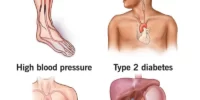Does Cirrhosis Cause High Blood Pressure

Cirrhosis causes changes in blood pressure. Cirrhosis, characterized by scar tissue in the liver, primarily leads to portal hypertension. Portal hypertension increases pressure in the portal vein. This condition can indirectly influence systemic blood pressure.
Blood pressure responses vary among patients with cirrhosis. Some patients experience hypertension due to altered vascular resistance. Other patients face hypotension as a result of cirrhosis. Renal sodium retention further complicates blood pressure management in cirrhosis.
Elevated blood volume from sodium retention requires close monitoring. Diuretics are often used as an intervention to manage blood pressure. Understanding cirrhosis and its impact on systemic hypertension is crucial. Further exploration will provide clarity on effective interventions for cirrhosis-related hypertension.
Key Takeaways
Cirrhosis leads to systemic hypertension. Altered hemodynamics and increased cardiac output are contributing factors. Portal hypertension, resulting from cirrhosis, elevates blood pressure in the portal vein. Systemic blood pressure is variably affected. Renal sodium retention in cirrhosis increases blood volume. This increase potentially contributes to systemic hypertension. Vascular tone dysregulation involves nitric oxide and endothelin. These factors impact blood pressure in cirrhosis. Effective management of hypertension in cirrhotic patients includes non-selective beta-blockers and diuretics.
Cirrhosis influence on blood
Cirrhosis, a progressive liver disease marked by scarring, significantly impacts blood composition and function. Liver dysfunction alters the synthesis of essential proteins and coagulation factors, leading to profound hematological complications.
Hypoalbuminemia, resulting from the liver’s inability to produce adequate albumin, reduces plasma oncotic pressure and may cause edema. Impaired synthesis of clotting factors predisposes individuals to bleeding disorders, complicating clinical management.
The detoxification processes in cirrhosis are affected, leading to toxins like ammonia accumulating in the bloodstream and contributing to hepatic encephalopathy. Prompt attention and intervention are required to prevent neurological decline.
Anemia can be induced by cirrhosis through hypersplenism, gastrointestinal bleeding, and folate deficiency, necessitating comprehensive evaluation and tailored therapeutic strategies. Research underscores the importance of monitoring hematological parameters in patients with cirrhosis to optimize care.
Delving into the complex interactions between cirrhosis and blood enhances patient care, improving quality of life and outcomes through informed and compassionate management.
Portal Hypertension Explained
Portal Hypertension represents a significant complication of cirrhosis. Scar tissue from cirrhosis disrupts normal blood flow through the liver. This disruption increases pressure in the portal vein, leading to portal hypertension. The condition has serious consequences, including variceal bleeding, ascites, and hepatic encephalopathy. Healthcare providers can improve patient care by recognizing the signs of portal hypertension and implementing timely interventions.
Portal hypertension results from increased vascular resistance and compensatory changes in blood flow. The liver’s compromised function impacts systemic circulation. This impact causes the dilation of blood vessels and the formation of collateral circulation.
The clinical manifestations of portal hypertension require attention to detail and a comprehensive understanding.
- Varices: Enlarged veins, mainly in the esophagus and stomach, are susceptible to life-threatening bleeding.
- Ascites: Fluid accumulation in the abdominal cavity causes discomfort and increases the risk of infection.
- Splenomegaly: Enlargement of the spleen occurs due to increased blood pooling, often resulting in thrombocytopenia.
Understanding these complications aids in providing compassionate, evidence-based care. Knowledge empowers patients to manage their condition effectively.
The role of healthcare providers is vital in mitigating risks and enhancing the quality of life for those affected by portal hypertension.
Cirrhosis and Systemic Blood Pressure
The relationship between cirrhosis and systemic blood pressure is a crucial topic in understanding cardiovascular implications of liver disease. Cirrhosis leads to portal hypertension. Portal hypertension increases vascular load, necessitating monitoring for variceal bleeding. Research indicates cirrhosis affects systemic blood pressure through altered vascular resistance and blood volume regulation. Cirrhosis can cause hypotension in some patients, while hypertension may occur in others due to compensatory mechanisms.
The table below summarizes key findings:
| Factor | Impact on Blood Pressure | Implications for Care |
|---|---|---|
| Portal Hypertension | Increases vascular load | Monitor for variceal bleeding |
| Renal Sodium Retention | Elevates blood volume | Consider diuretics |
| Systemic Vasodilation | Lowers resistance | Monitor for hypotension |
Monitoring systemic blood pressure in cirrhosis patients is essential. It allows you to tailor interventions addressing both hypotensive and hypertensive states. Understanding these dynamics provides comprehensive care, potentially improving patient outcomes. Continuous learning about the latest research and treatment strategies enables addressing the complex needs of cirrhosis-affected individuals.
Physiological Changes in Cirrhosis
Cirrhosis induces a multitude of physiological changes, significantly affecting various organ systems. Cirrhosis progression alters hepatic architecture, resulting in portal hypertension, a critical factor influencing systemic complications. The condition causes a cascade of hemodynamic changes, promoting blood flow resistance in the portal vein. Collateral circulation develops to bypass the liver, which can lead to varices.
The liver’s compromised synthetic function impairs albumin production, contributing to vascular instability and ascites formation. Splanchnic vasodilation further exacerbates circulatory dysfunction, enhancing the kidneys’ response to retain sodium and water, thereby intensifying fluid overload.
Key physiological changes include:
- Portal Hypertension: Elevated pressure in the portal venous system leads to variceal formation and potential gastrointestinal bleeding.
- Hepatorenal Syndrome: Renal function deterioration occurs due to altered blood flow and systemic vasoconstriction, exacerbating renal insufficiency.
- Hepatic Encephalopathy: Accumulation of neurotoxins like ammonia due to impaired liver detoxification affects cognitive function.
The understanding of these changes allows for better assistance to individuals impacted by cirrhosis, optimizing therapeutic interventions and improving quality of life through informed, compassionate care.
Researches on Cirrhosis and Hypertension
Emerging research on cirrhosis and hypertension underscores the intricate relationship between these two conditions, highlighting the systemic impact of liver dysfunction on vascular health.
The systemic hypertension in cirrhotic patients is gaining attention. Portal hypertension, a hallmark of cirrhosis, is well-documented. Researchers note that altered hemodynamics in cirrhosis can lead to increased cardiac output and peripheral vasodilation. Altered hemodynamics influence blood pressure regulation.
Nitric oxide and endothelin are vasoactive substances that are dysregulated in cirrhosis. These substances contribute to vascular tone alterations and hypertension. Cirrhosis-associated hyperdynamic circulation affects systemic vascular resistance. Systemic vascular resistance has implications for hypertension management.
Renal function is an important factor in this context. Cirrhosis often leads to renal vasoconstriction, exacerbating hypertension. The interplay between liver dysfunction and kidney health is a crucial area of investigation.
Multidisciplinary approaches are needed for managing cirrhotic patients effectively.
Notable research findings on cirrhosis and hypertension:
- Portal hypertension in cirrhosis: Research has shown that portal hypertension is a major complication of cirrhosis. Key studies have focused on:
- The role of hepatic stellate cell activation in increasing intrahepatic resistance
- Development of portosystemic collaterals and esophageal varices
- Use of beta-blockers to reduce portal pressure
- Cirrhotic cardiomyopathy: Studies have identified a syndrome of cardiac dysfunction in cirrhosis patients, characterized by:
- Impaired contractile responsiveness to stress
- Altered diastolic relaxation
- Electrophysiological abnormalities
- Renin-angiotensin-aldosterone system (RAAS) in cirrhosis: Research has revealed:
- Hyperactivation of RAAS in cirrhosis
- Contribution to sodium retention and ascites formation
- Potential therapeutic targets for managing complications
- Non-alcoholic fatty liver disease (NAFLD) and hypertension: Studies have found:
- Higher prevalence of hypertension in NAFLD patients
- Shared risk factors like insulin resistance and obesity
- Potential for NAFLD as an independent risk factor for hypertension
- Hepatorenal syndrome: Important research on this severe complication of cirrhosis has focused on:
- Pathophysiology involving splanchnic vasodilation and renal vasoconstriction
- Use of vasoconstrictors like terlipressin in management
- Role of transjugular intrahepatic portosystemic shunt (TIPS) in treatment
- Cirrhosis and pulmonary hypertension: Studies on hepatopulmonary syndrome and portopulmonary hypertension have examined:
- Mechanisms of intrapulmonary vascular dilatation
- Screening methods using contrast echocardiography
- Potential treatments including liver transplantation
Managing Blood Pressure in Cirrhosis
The management of blood pressure in cirrhosis necessitates a comprehensive grasp of the pathophysiological changes linked to liver dysfunction. Cirrhosis induces portal hypertension, affecting systemic blood pressure regulation. The primary objective is to address both portal and systemic hypertension while minimizing adverse effects on liver function.
Non-selective beta-blockers play a critical role in reducing portal pressure and preventing variceal bleeding. Diuretics are essential for managing ascites; however, meticulous monitoring of electrolyte balance is required to prevent complications.
Lifestyle modifications include encouraging low-sodium diets and moderate exercise, tailored to individual tolerance and health status.
Research on novel therapeutic agents and interventions, such as Transjugular Intrahepatic Portosystemic Shunt (TIPS), is vital for modulating portal pressure.
Collaboration with a multidisciplinary team, including hepatologists and cardiologists, is crucial to optimize patient outcomes. A deep understanding of these complexities significantly enhances the quality of care for individuals affected by cirrhosis.
Implications for Patient Health
The management of blood pressure in cirrhosis is essential for patient health. Portal hypertension, a complication of cirrhosis, can exacerbate systemic hypertension. This leads to risks such as renal failure, hepatic encephalopathy, and variceal hemorrhage. Understanding these interconnected mechanisms emphasizes the need for tailored treatment plans addressing both hepatic and cardiovascular systems.
Current research indicates that an integrated approach to managing cirrhosis can reduce potential complications. Non-selective beta-blockers, including propranolol, effectively target portal hypertension and help control systemic blood pressure. This dual-action pharmacological strategy underscores the importance of vigilant monitoring and therapeutic regimen adjustments.
Lifestyle modifications, like sodium restriction and fluid management, significantly reduce ascites and edema. This alleviates additional circulatory strain.
Encouraging adherence to these recommendations enhances the quality of life for patients. Healthcare providers must engage proactively in educating and supporting patients with evidence-based strategies. A holistic approach ensures optimal outcomes in managing cirrhosis with concurrent hypertension.
Frequently Asked Questions
Can Lifestyle Changes Prevent Cirrhosis-Related High Blood Pressure?
Cirrhosis-related hypertension can be mitigated through lifestyle changes. A low-sodium diet is essential for managing cirrhosis-related hypertension. Regular exercise contributes to the management of portal hypertension. Limiting alcohol intake supports better liver function. Healthcare professionals should be consulted for tailored guidance and monitoring.
What Are the Early Symptoms of Cirrhosis-Induced Hypertension?
The topic of the article is Cirrhosis-Induced Hypertension. Fatigue is an early symptom of this condition. Abdominal swelling often occurs in affected individuals. Confusion may present as another symptom. Monitoring portal hypertension indicators is essential. Ascites and varices are critical indicators of Cirrhosis-Induced Hypertension. Early detection significantly improves patient outcomes. Medical intervention plays a vital role in managing Cirrhosis-Induced Hypertension.
How Does Diet Affect Blood Pressure in Cirrhosis Patients?
The impact of diet on blood pressure in cirrhosis patients is substantial. Dietary sodium reduction significantly affects fluid retention and portal hypertension. Sodium intake management decreases fluid retention. Cirrhosis patients benefit from balanced nutrition. A focus on fresh produce and lean proteins enhances health outcomes. Limiting processed foods is crucial for optimal health.
Are There Alternative Treatments for Managing Hypertension in Cirrhosis?
The management of hypertension in cirrhosis can benefit from non-pharmacological interventions. Dietary sodium restriction, exercise, and mindfulness-based stress reduction offer effective methods. Research indicates these strategies help manage hypertension while minimizing medication-related hepatic complications. This approach provides holistic care for cirrhosis patients.
Is High Blood Pressure Reversible in Cirrhosis Patients?
The topic of the article is high blood pressure in cirrhosis patients. High blood pressure in cirrhosis is not fully reversible. Managing high blood pressure in cirrhosis is possible. Lifestyle modifications can play a significant role in management. The reduction of sodium intake is essential. Healthcare providers should be consulted for personalized treatment plans. Enhancing the quality of life and care is the goal.









